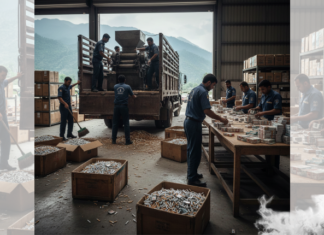ISLAMABAD: On February 17, 2023, the 330 Megawatt lignite-fired power plant operated by Hub Power Company Limited (HUBCO) began commercial operations. The China Pakistan Economic Corridor’s ThalNova is a 330-Megawatt mine-mouth lignite-fired power station located at Thar Coal Block II Sindh (CPEC).
HUBCO, Thal Limited, Novatex Limited, China Machinery Engineering Corporation (CMEC), and Descon Engineering Ltd are partners in the project.
According to the press release from the company, The boiler, turbine, and generator used in the power plant were produced by General Electric, of American origin. Whereas, other systems in the power plant are based on European technology.
As a result, reliability criteria are raised and emissions are regulated to levels even lower than those permitted by the Sindh Environmental Protection Agency (SEPA). This is to counter the wider argument of air pollution incurred by burning coal for power.
Earlier this month, the Private Power and Infrastructure Board (PPIB) declared that the country’s largest Thar coal-based power facility has reached Commercial Operation Date (COD). The Shanghai Electric project, located at Thar Block-1 with a generation capacity of 1,320 MW, was implemented as part of the China-Pakistan Economic Corridor (CPEC).
Thar Coal Block-1 Power Generating Co, a wholly-owned subsidiary of Shanghai Electric, developed the project. The project cost is estimated at around $ 2 billion and is estimated to generate 9 billion units of power per year, saving Rs. 250 billion each year, that would have otherwise been used to import gas for power production.
Coal power on the grid…
At the moment apart from the two new power plants that achieved COD this month, the country is running five operating coal power plants owned by; Thar Engro Coal Power Project (Thar, Sindh), Lucky Electric Power Company Limited (Karachi, Sindh), Port Qasim Electric Power Company (Karachi, Sindh), China Power Hub Generation Company (Hub, Balochistan) and Huaneng Shandong Rui Group (Sahiwal, Punjab).
The combined capacity of these plants is 1,980 MW and apart from the Engro coal power plant in Thar, all other plants are currently relying on imported coal to produce electricity. Although it must be noted that the Lucky Electric power plant is configured to use domestic coal; it is temporarily importing coal and will shift to coal extracted from Thar once the second phase of expansion of the mine is completed.
Adding on the new coal-based power plants to the grid brings the total energy coming from coal at 3630 MW. This is a mighty increase of 80% from the previous year, and all of it is coming from domestically produced coal reducing the strain on the foreign exchange reserves of the country.
Not so easy there…
However, earlier this year Sindh Engro Coal Mining Company (SECMC) in a letter had sought the State Bank of Pakistan’s (SBP) approval for establishing LCs for additional mining equipment.
In this letter of theirs, the company asked for support regarding SBP’s approval for LC opening needed for critical imports required to keep the mine operational. “We need approval for the opening of our regular LCs to ensure continuous supply of tyres and spares parts for our mining equipment,” read the letter.
The supply chain needed to keep the machines running at the mine can be compromised due to the sensitive foreign exchange situation. These delays directly affect the operations of the mine as a constant flow of spare parts is needed to keep the machinery in running order.
The Thar coal based power plants rely on a constant supply of coal from the mine, any obstacles in this chain would affect the operations of the power plants and can potentially lead to rolling blackouts or worse.
Energy experts have also questioned Pakistan’s ability to finance more of the proposed coal fleet because China and Japan, two of the largest financiers of coal units in developing nations, have recently withdrawn their support for fossil fuel projects due to pressure from environmentalists and Western governments.
And to cap it all, according to the Finance supplementary bill, the government has increased sales tax from 17 to 18% on locally produced Coal, a subsequent impact of which is bound to be seen in commodity prices.
The Energy minister Khurram Dastagir, however, told the media that Pakistan plans to increase domestic coal-fired power capacity to 10 gigawatts (GW) in the medium-term, from 2.31 GW currently. How the country plans to achieve these ambitious targets is what needs to be explained.
























Why the government has increased sales tax from 17 to 18%?
It can create jobs and stimulate economic growth in the Thar region, where the coal is produced. Additionally, the use of coal can help address energy poverty by providing affordable and accessible electricity to communities that previously lacked access to it.